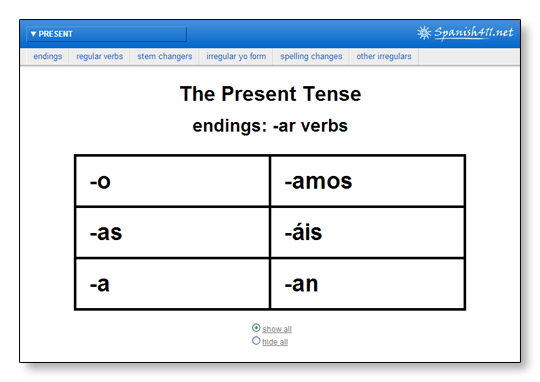|
||||||||||||||||||||||||||||||||||||||||||||||||||||||||||||||||||||||||||||||||||||||||||||||||||||||||||||||||||||||||||||||||||||||||||||||||||||||||||||||||||||||||||||||||||||||
 |
||||||||||||||||||||||||||||||||||||||||||||||||||||||||||||||||||||||||||||||||||||||||||||||||||||||||||||||||||||||||||||||||||||||||||||||||||||||||||||||||||||||||||||||||||||||
 |
||||||||||||||||||||||||||||||||||||||||||||||||||||||||||||||||||||||||||||||||||||||||||||||||||||||||||||||||||||||||||||||||||||||||||||||||||||||||||||||||||||||||||||||||||||||
The Present Tense (Part 1)
Present Tense ConjugationsSee also: The Present Tense (Part 2) Now that you know the general concept behind conjugating verbs, it’s time to practice with traditional first verb tense, the present tense. As you would expect, we use the present tense to describe a present action or how things currently are. In Spanish we can even use it to express actions in progress: They live in Guatemala. Here’s what you need to know about conjugating and using the present tense: Regular Present Tense VerbsTo conjugate a verb in the present tense, drop the “-ar,” “-er,” or “-ir” from the infinitive and add the appropriate ending to the stem: “-ar” endings:
“-er” endings:
“-ir” endings:
Notice how similar the “-er” and “-ir” endings are. Also note the accent mark in every vosotros ending. Here are some examples for the verbs vivir, hablar, and comer: Viven en Guatemala.  Let’s practice! Conjugate regular present tense verbs on ¡Practiquemos! Stem Changing Present Tense VerbsIt would be nice if that were all there was to it, but the Spanish present tense is actually fairly complicated compared to other tenses. One of the first issues to discuss is a class of verbs known as “stem changing” verbs which do not follow the normal conjugation rules. As the name implies, the stems of these verbs change when they are conjugated. One common stem changer is the verb dormir (to sleep). Normally, you would expect the stem to be “dorm” after removing the “-ir” ending. However, dormir is what’s known as an “o to ue” stem changer. That means we change the “o” to a “ue” whenever we conjugate in the present tense, and the stem becomes “duerm”. Check out the present tense conjugations of dormir: dormir (o → ue):
Wait a minute, what’s going on with the nosotros and vosotros conjugations? The stems of stem changing verbs don’t change for every subject — nosotros (we) and vosotros (you all) conjugations remain the same. If you look at the pattern made by the stems in a typical conjugation grid, you can see the changed stems form the shape of a shoe or boot. Because of this, stem changing verbs are often called “boot verbs.” See? Note: When the stress of the conjugation falls on the stem, there is a stem change. When the stress falls on the ending, there is no change. dormir (o → ue):
There are three kinds of stem changing verbs: o→ue verbs, e→ie verbs, and e→i verbs. All of them are conjugated following the same boot verb pattern. You cannot just figure out whether a verb is a stem changer by looking at it. There are no hard and fast rules as to why certain verbs are stem changers. Your best bet is simply to memorize which verbs fall into which category. And remember, just because a stem has an “e” or an “o” in it doesn’t necessarily mean that it’s a stem changer. Stem Changers: e→ieThe following verbs are the most common e→ie stem changers: Note: Verbs based on these verbs will have the same stem changes, e.g.: detener → detienen. cerrar (to close) entender (to understand) querer (to want) They are conjugated like this: pensar (e→ie):
Stem Changers: o→ueThe following verbs are the most common o→ue stem changers: Note: Verbs based on these verbs will have the same stem changes, e.g.: devolver → devuelven. almorzar (to eat lunch) morir (to die) resolver (to resolve) They are conjugated like this: poder (o→ue):
Stem Changers: e→iNote: Verbs based on these verbs will have the same stem changes, e.g.: despedir → despiden. The following verbs are the most common e→i stem changers: corregir (to correct) medir (to measure) seguir (to follow) They are conjugated like this: Note: Only “-ir” verbs have an e→i stem change. pedir (e→i):
Dictionaries and other resources typically denote stem changing verbs like this: dormir (o-ue), dormir (o:ue) or dormir (ue).  Let’s practice! Conjugate stem changing present tense verbs on ¡Practiquemos! Irregular Present Tense VerbsIn addition to stem changing verbs, there are many other irregular verbs in the present tense that don’t follow the normal rules. Irregular Yo Form VerbsSome verbs do weird things only in the yo form conjugations. Take dar (to give) for example. It follows the rules for all of its conjugations except for the yo form: dar:
Here is a list of common verbs with irregular yo form conjugations:
Remember, with these verbs only the yo form is irregular. Other Irregular Yo Form VerbsThe list above isn’t exhaustive; it’s not even close. There are many other verbs with irregular yo form conjugations. In fact, there are so many that we put them into categories and don’t really treat them as being irregular. Other Irregular Yo Form Verbs: “-go” VerbsSeveral verbs have irregular yo form conjugations that end in “-go.” Hacer (to make, to do) is a good example: hacer:
Note: Verbs based on these irregular verbs will have the same irregularities, e.g.: detener → detengo. Here’s a list of common “-go” verbs:
Note that in addition to the irregular “-go” ending, some of these verbs have other irregularities. For example traer doesn’t become “trago,” it becomes “traigo.” Other Irregular Yo Form Verbs: “-zco” VerbsNote: Verbs that end in a vowel followed by “-cer” or “-cir” are “-zco” verbs. Several verbs have irregular yo form conjugations that end in “-zco.” Conocer (to know) is a good example: conocer:
Note: Verbs based on these irregular verbs will have the same irregularities, e.g.: reconocer → reconozco. Here’s a list of common “-zco” verbs:
Twice Exceptional VerbsSome verbs can actually be irregular in more than one way. Decir (to say, to tell) is just such a verb. It is both an e→i stem changer and a “-go” verb. Check out its conjugations: decir (e→i):
Other Irregular Present Tense VerbsThere are other irregularities and weird rules in the present tense, but they aren’t very common and you don’t need to worry about them now. However, you should be familiar with the following present tense conjugations before you get too much further. They are useful verbs and occur frequently: ir (to go):
jugar (to play):
estar (to be):
ser (to be):
To learn more about why these verbs and others are conjugated the way they are, see The Present Tense (Part 2). (If you’re curious how both estar and ser can mean “to be,” check out Using Ser and Estar.)  Let’s practice! Conjugate irregular present tense verbs on ¡Practiquemos! Using the Present TenseWe use the present tense to describe the way things are now or how they usually happen. Tengo dieciséis años. Mi amigo toca el saxofón. Siempre vamos al centro comercial los viernes. We can also use the present tense to describe things that are currently happening. En este momento hago mi tarea. Mi amigo toca el piano ahora. Vamos al centro comercial ahorita. See also: The Present & Imperfect Progressive Note: We typically wouldn’t use the present tense in this way in English; we’d use the present progressive instead. It would be perfectly acceptable to write these sentences in Spanish using the present progressive, but we don’t have to. Additionally, as in English, we can use the present to discuss things that will happen soon. Voy al médico mañana. We can even talk about past events using the present tense to make a story seem more immediate and interesting. Finalmente el general mueve sus tropas y ataca la ciudad del sur. Newspapers are fond of doing this in headlines. |
||||||||||||||||||||||||||||||||||||||||||||||||||||||||||||||||||||||||||||||||||||||||||||||||||||||||||||||||||||||||||||||||||||||||||||||||||||||||||||||||||||||||||||||||||||||
 This work by Spanish411.net is licensed under a Creative Commons Attribution-NonCommercial-ShareAlike 4.0 International License. This work by Spanish411.net is licensed under a Creative Commons Attribution-NonCommercial-ShareAlike 4.0 International License. |



